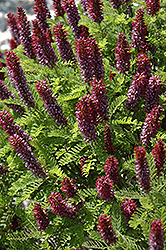Height: 12 inches
Spread: 24 inches
Sunlight:
![]()
Hardiness Zone: 3
Other Names: Dwarf Leadplant
Description:
Beautiful and unusual massing of tiny contrasting flowers rise over ferny foliage, each comprised of a single purple petal and gold stamen, can only be appreciated at close range, attract native butterflies; roots do not like to be disturbed
Ornamental Features
Dwarf Wild Indigo Bush has masses of beautiful spikes of indigo pea-like flowers with gold anthers rising above the foliage in mid summer, which are most effective when planted in groupings. It has grayish green deciduous foliage. The tiny fuzzy narrow pinnately compound leaves do not develop any appreciable fall color.
Landscape Attributes
Dwarf Wild Indigo Bush is a multi-stemmed deciduous shrub with a ground-hugging habit of growth. It lends an extremely fine and delicate texture to the landscape composition which should be used to full effect.
This is a relatively low maintenance shrub, and is best pruned in late winter once the threat of extreme cold has passed. It is a good choice for attracting bees, butterflies and hummingbirds to your yard, but is not particularly attractive to deer who tend to leave it alone in favor of tastier treats. It has no significant negative characteristics.
Dwarf Wild Indigo Bush is recommended for the following landscape applications;
- Mass Planting
- Hedges/Screening
- Rock/Alpine Gardens
- Border Edging
- General Garden Use
- Naturalizing And Woodland Gardens
Planting & Growing
Dwarf Wild Indigo Bush will grow to be about 12 inches tall at maturity, with a spread of 24 inches. It tends to fill out right to the ground and therefore doesn't necessarily require facer plants in front. It grows at a slow rate, and under ideal conditions can be expected to live for approximately 10 years.
This shrub should only be grown in full sunlight. It prefers dry to average moisture levels with very well-drained soil, and will often die in standing water. It is considered to be drought-tolerant, and thus makes an ideal choice for a low-water garden or xeriscape application. It is particular about its soil conditions, with a strong preference for poor, alkaline soils, and is able to handle environmental salt. It is somewhat tolerant of urban pollution. This species is native to parts of North America.
